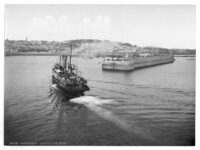Nestled on the rugged Yorkshire coast, Whitby flourished during the Victorian era as a bustling maritime town, steeped in industry, tourism, and local traditions. Its narrow streets, lined with fishermen’s cottages and elegant Georgian houses, bore witness to the daily lives of sailors, traders, and visitors seeking both business and leisure. The town’s dual identity as a thriving port and a picturesque retreat attracted artists, writers, and holidaymakers, drawn by its dramatic landscape and rich history.
One of the most iconic landmarks of Whitby is the Whitby Abbey, standing tall atop the East Cliff. This medieval ruin, long abandoned, gained renewed interest in the 19th century when Gothic Revival enthusiasm swept through England. Its haunting beauty, enhanced by the eerie silhouette against the sky, inspired literature, most notably Bram Stoker’s Dracula. Below the Abbey, St. Mary’s Church and its weathered gravestones overlooked the harbor, further adding to the town’s mystical allure.
Robin Hood’s Bay, a short journey from Whitby, exemplified the area’s deep connection to the sea. In Victorian times, it remained a hub for fishing and, as folklore suggests, smuggling. The steep, winding alleyways and tightly clustered cottages whispered tales of clandestine trade and hidden contraband, adding an air of mystery to the village’s charm.
Beyond Whitby’s heart, Runswick Bay and Staithes stood as fishing communities, where locals braved the harsh North Sea to sustain their livelihoods. These coastal settlements, linked to Whitby by trade and seafaring culture, contributed to the region’s maritime identity. Staithes, in particular, became a haven for artists in the Victorian period, who sought to capture the rugged beauty of the Yorkshire coastline in their paintings.
Further inland, Larpool provided sweeping views of Whitby and the Esk Valley, illustrating the picturesque beauty that drew visitors from all over England. Nearby, Glaisdale and Beggars’ Bridge carried their own romantic stories, the latter named after a legend of a poor lover who built the bridge to reach his beloved. These rural settings contrasted with the bustling activity of Whitby’s harbor, yet they remained intrinsically connected to the town’s economic and social fabric.
The pier in Whitby, with its wooden boardwalk and lighthouse, served as a place of both commerce and recreation. Ships set sail from its docks, carrying goods and passengers to distant shores, while Victorian tourists enjoyed the refreshing sea air and the excitement of watching vessels come and go. Seaside promenades and piers were essential aspects of 19th-century leisure culture, and Whitby’s was no exception.
Throughout the Victorian period, Whitby continued to evolve, balancing its traditional maritime heritage with emerging tourism and industry. The expansion of the railway brought more visitors, fueling the growth of hotels, guesthouses, and tea rooms that catered to the middle-class holidaymakers. Yet, despite these modern influences, the town retained its distinctive character—one shaped by its people, its landscape, and its deep connection to the sea.
Today, echoes of Whitby’s Victorian past remain visible in its architecture, cobbled streets, and the enduring legacy of its most famous landmarks. The town, much like the photographs of the era, stands as a testament to a bygone time, where the romance of the sea met the industrious spirit of its people.


















